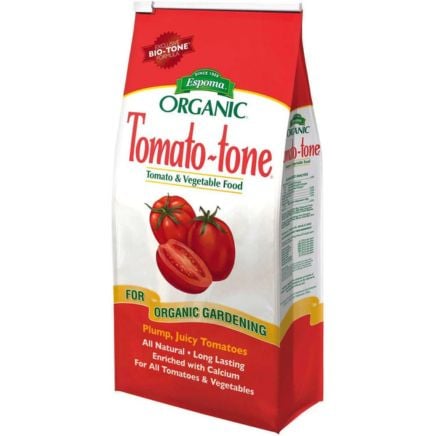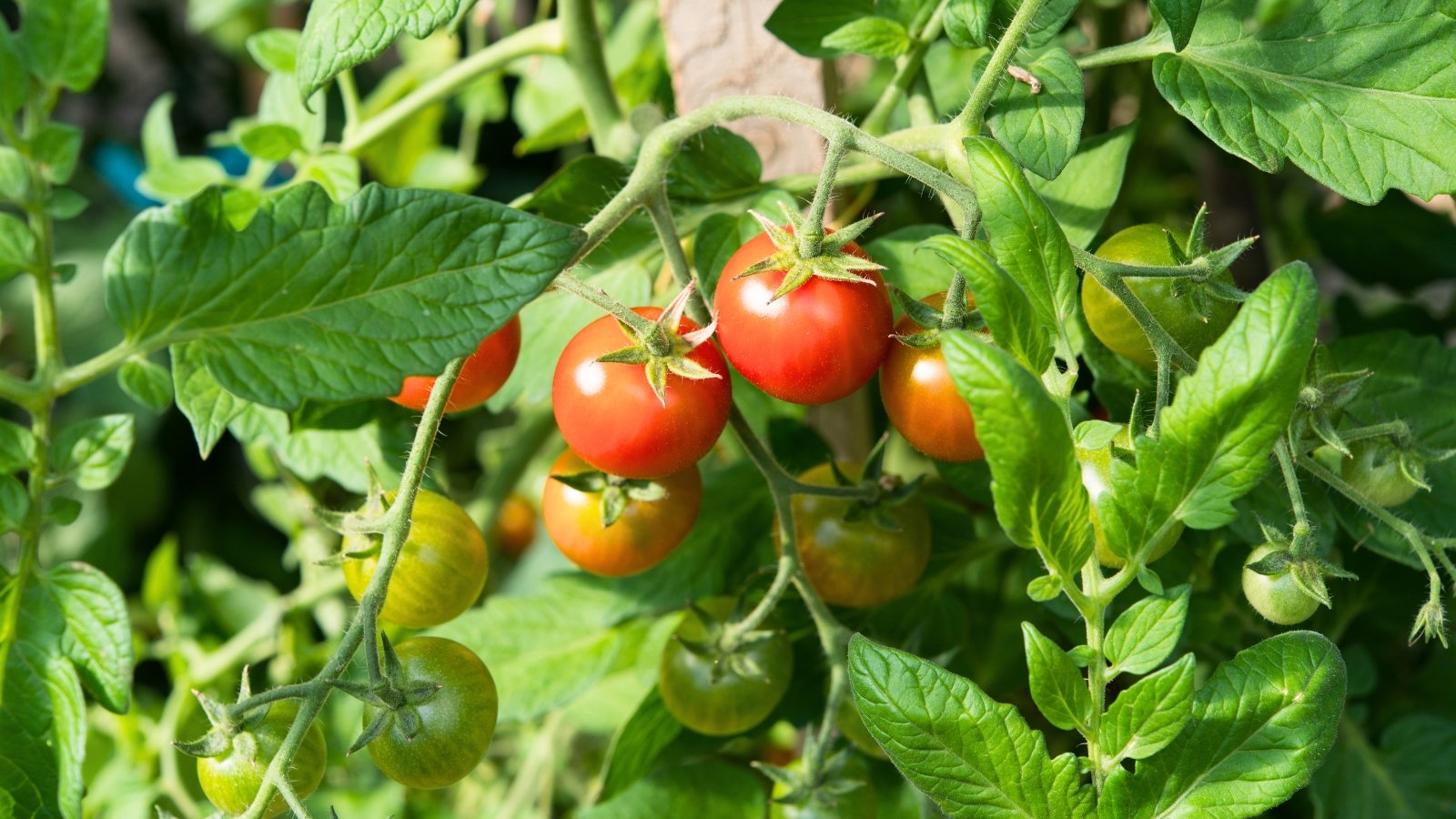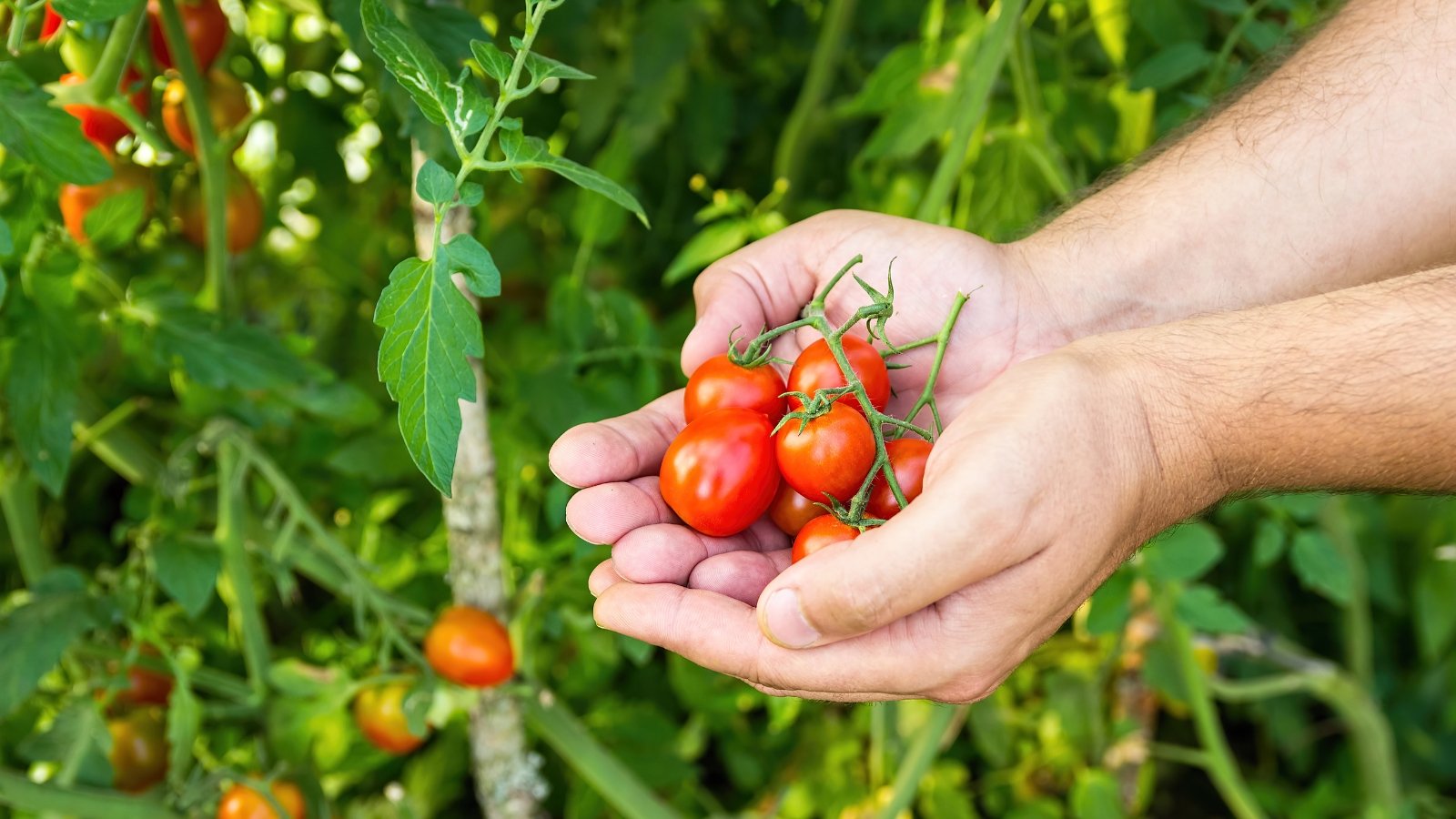PROTECT YOUR DNA WITH QUANTUM TECHNOLOGY
Orgo-Life the new way to the future Advertising by AdpathwayI used to think determinate tomato varieties were less ideal than indeterminate ones. Boy, was I wrong! Determinate tomatoes, though they develop all at once, are great for gardeners with short growing seasons. They also work well for home cooks who like to can or preserve their tomatoes.
Unlike indeterminate pole tomatoes, bushy determinate ones flower and fruit all at once instead of throughout the growing season. There are hybrid varieties that produce fruit earlier than most other types. ‘Cherry Falls’ is one such variety. It grows a wealth of cherry-sized tomatoes before pole types sprout flowers!
Whether you’re growing this kind for the first time or brushing up on how to care for it best, this guide has all the information you need to keep your crop happy, healthy, and productive.
Cherry Falls Tomato Seeds

Cherry Falls Bush Cherry Tomato Seeds
Espoma Tomato Fertilizer

Espoma Tomato-tone Organic Plant Food

The Ultimate Seed Starting Kit
‘Cherry Falls’ Tomato Overview

|
Plant Type Frost-tender perennial Family Solanaceae Genus Solanum Species lycopersicum |
Native Area South America Exposure Full sun Height 18” Watering Requirements High |
Pests & Diseases Many Maintenance Average Soil Type Loam, well-drained Hardiness Zone 3-11 |
What Is It?
 Regular picking keeps those tiny red gems coming back.
Regular picking keeps those tiny red gems coming back.‘Cherry Falls’ is a hybrid tomato variety that grows clusters of grape-sized fruit. Though it’s determinate, you can prolong its growing season by harvesting consistently. Routine picking can encourage new growth that sprouts fruit after the first harvest.
Native Area
 Warmer regions tend to favor the nonstop climbers.
Warmer regions tend to favor the nonstop climbers.All of our current tomatoes originated from wild ancestors in South America. The ancient Inca Empire had farmers, gardeners, and growers who cultivated new varieties from wild specimens near Peru. These new types spread throughout the world through trade, after which breeders in other countries bred new tomato types.
This is why, nowadays, different countries have their favorite tomatoes. Quick-growing, determinate varieties are popular in cold areas like Canada and Russia, while indeterminate types are widespread in gardens with warm, frost-free climates.
Characteristics
 These cherry-colored fruits hang low and sweeten with time.
These cherry-colored fruits hang low and sweeten with time.‘Cherry Falls’ grows short vines that max out around 18 inches long. Off the vines sprout multiple new shoots with flower clusters and, eventually, fruit! The short vines may grow longer than 18 inches if they hang down from raised beds, planters, or hanging baskets.
The tomatoes themselves have a sweet, semi-tart flavor that sweetens the longer they sit on the vine. They’ll give when you squeeze them, indicating they’re ripe and ready to eat. The small, round fruits are perfect for fresh eating, salads, and sauces.
The foliage isn’t as dense and bushy as other types. It’s incredibly ornamental! You’ll appreciate the spear-shaped leaves and compact stems. This variety’s size is perfect for container growing.
Planting
Whether you purchase seedlings at the store or grow them from seeds, they’re easy to care for and transplant into the garden. They appreciate warm temperatures, consistent moisture, and bright light.
Growing from Seed
 A sunny window can raise the strongest early starts.
A sunny window can raise the strongest early starts.Growing tomatoes from seeds is an ideal way to get big, beefy plants before nurseries have them for sale. Growers in regions with long, cold winters and short growing seasons can start plants during the winter indoors, then transplant them outdoors after the danger of frost passes.
To start seeds indoors, you may need the following materials:
- Trays
- Pots
- Potting Soil
- Humidity Dome
- Heat Mat
- Grow Light
- Watering Can
These materials provide the ideal environment for germinating seeds. Fill your pots with potting soil, moisten them, then plant three seeds an eighth of an inch deep in each one. The trays catch draining water, and the humidity dome goes over the tops to maintain an ideal humidity level.
Heat mats go underneath the trays. They heat the pots to optimal germination temperatures for tomatoes, between 70-90°F (21-32°C). If your house is warm, the heat mat may not be necessary. Grow lights are optional, too, for growers with bright, well-lit windows. In dark rooms, a plant grow light helps boost the brightness.
After the seedlings sprout, remove the heat mat and humidity dome and keep them under bright light. Thin the pots so one seedling remains in each one. Transplant them outdoors once the night temperatures remain above 45°F (7°C).
Transplanting
 Gradually introducing young plants to outside life is key.
Gradually introducing young plants to outside life is key.Once you have seedlings, you’re ready to put them in your garden. Bravo! If you start them indoors, they need to harden off before you can plant them. Hardening off is a one to two-week period where the plants adapt to outdoor light levels, temperatures, and winds. Place them outside for a few hours each day, increasing the amount over two weeks.
After hardening off the plants, start preparing the holes for planting. Fill containers with potting soil or compost, and leave room for the seedlings’ rootballs. Prepare planting beds by digging holes as deep and twice as wide as the rootballs.
Loosen the seedlings from their pots, tapping on the bottoms until they lift out. Place them in their holes, fill the holes with soil, and water the site well. An optional bonus step is to add compost! A two to three-inch-thick layer on top of the ground insulates, feeds, and protects the roots beneath.
How to Grow
‘Cherry Falls’ thrives in a wide range of gardens. Give it the care it needs, and it’ll provide you with bushels of fruit throughout the summer. Plant many in a large pot, or give each one its own home and space. No matter how big or small your yard is, this tomato will easily tuck into every empty nook and cranny.
Light
 Six hours of sun daily keeps plants thriving well.
Six hours of sun daily keeps plants thriving well.Tomatoes need full sun to thrive. Give them six or more hours of daily direct sunlight. Afternoon shade is okay in especially warm climates, though excessive shade is harmful to your crop. Shaded plants may have more pests and diseases than well-lit ones.
Water
 Keep soil damp but avoid drowning roots.
Keep soil damp but avoid drowning roots.Regular moisture is essential if you’d like to grow plump, juicy tomatoes. Infrequent watering leads to cracking, splitting, and poorly formed fruits. Keep the soil moist, but not soggy, so long as the plants are growing and fruiting.
Soil
 Good soil drains well but holds enough moisture.
Good soil drains well but holds enough moisture.Loamy, well-drained soil is the perfect medium for growing this cultivar. Potting soil has this ideal mix, though you can make it yourself with pumice, compost, and the garden’s existing soil. Blend the three ingredients, then plant the tomatoes into the final mixture.
Fertilizing
 Adding potassium at fruit time makes all the difference.
Adding potassium at fruit time makes all the difference.Tomatoes are high feeders, though cherry tomatoes need less fertilizer than slicers and large heirloom varieties. Give them a high-potassium organic fertilizer once fruits begin to appear. Nutrient-rich soils may not need additional fertilizer. Consider doing a soil test to see the nutrient levels in your garden’s soil.
Maintenance
 Let vines spill freely or gently guide them upward.
Let vines spill freely or gently guide them upward.Tomatoes are high-maintenance because they typically need caging, fertilizing, and plenty of water. ‘Cherry Falls’ is significantly easier to care for than most other types. You may give it support if you’d like it to grow upright, or let it drape over the edges of containers and baskets.
Propagation
Though you can propagate heirloom varieties with seeds or cuttings, hybrid varieties like this cultivar are difficult to propagate. Hybrid varieties are the result of a cross between two parent plants. If you save their seeds, they will sprout tomato plants completely different than ‘Cherry Falls.’ Take cuttings to propagate this variety.
Cuttings
 Cuttings need moisture and a cozy, humid little home.
Cuttings need moisture and a cozy, humid little home.To take cuttings, find healthy portions of your plant with ample leaves and shoots. Locate a stem, then snip off a portion with three or more leaves. Remove the flowers and fruits, then place the cut stems in pots with potting soil.
Cover the pots with a humidity dome, and keep the soil moist, but not soggy. The cut stems will sprout roots in a few days. After they root, remove them from their pots and transplant them where you’d like them to grow.
Harvesting and Storage
 Pick when plump and red for the best flavor.
Pick when plump and red for the best flavor.Harvest the cherry-sized tomatoes when they’re red, plump, and slightly squishy. Keep them on the kitchen counter for fresh eating, or store them in the fridge until you’re ready to use them.
You may also can, freeze, or dry the fruits for long-term storage. Use pressure canning to preserve them, or blend them into a liquid and freeze them in cubes for cooking throughout the year.
Common Problems
Tomato plants attract plenty of pests and diseases! The best way to prevent infestations or infections is to keep your plants healthy during the growing season. Healthy plants resist external pressures better than shaded or poorly fed ones.
Pests
 Targeted treatments help protect good bugs and plants.
Targeted treatments help protect good bugs and plants.Watch for the following pests on your plants:
- Aphids
- Cabbage looper
- Cutworms
- Flea beetles
- Potato beetle
- Red spider mites
- Slugs
- Stink bugs
- Tobacco hornworms
- Tomato fruit worms
- Tomato hornworms
- Whiteflies
Spray them off with water, or use a treatment plan that targets the specific pest you see. Avoid using broad-spectrum insecticides, as these tend to harm a wide array of beneficial insects that eat pests and pollinate flowers. Promote beneficial insects with a diverse array of nectar plants planted near your tomatoes.
Diseases
 Blights and wilts hit plants struggling in poor conditions.
Blights and wilts hit plants struggling in poor conditions.Watch for these diseases on your tomatoes:
- Blights
- Blossom end-rot
- Fusarium wilt
- Tobacco mosaic virus
- Verticillium wilt
Diseases are prevalent in plants growing in poor conditions. Take stock of your garden, then address any problems you identify. Tobacco mosaic virus can spread from tobacco products onto your plants, so be careful if you use them near the garden. Wilts are not treatable, and plants with wilt should be removed in order to prevent the spread of disease to other plants.


 4 weeks ago
23
4 weeks ago
23





















 English (US) ·
English (US) ·  French (CA) ·
French (CA) ·